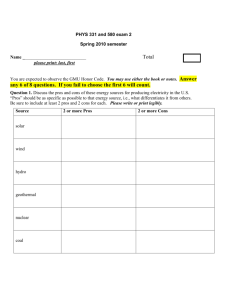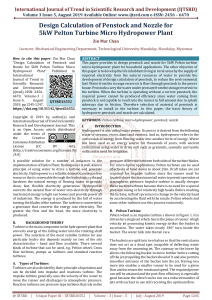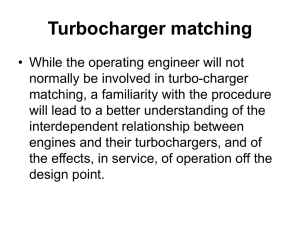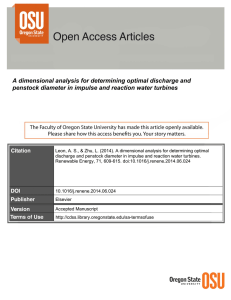Project_ENSC 283
advertisement
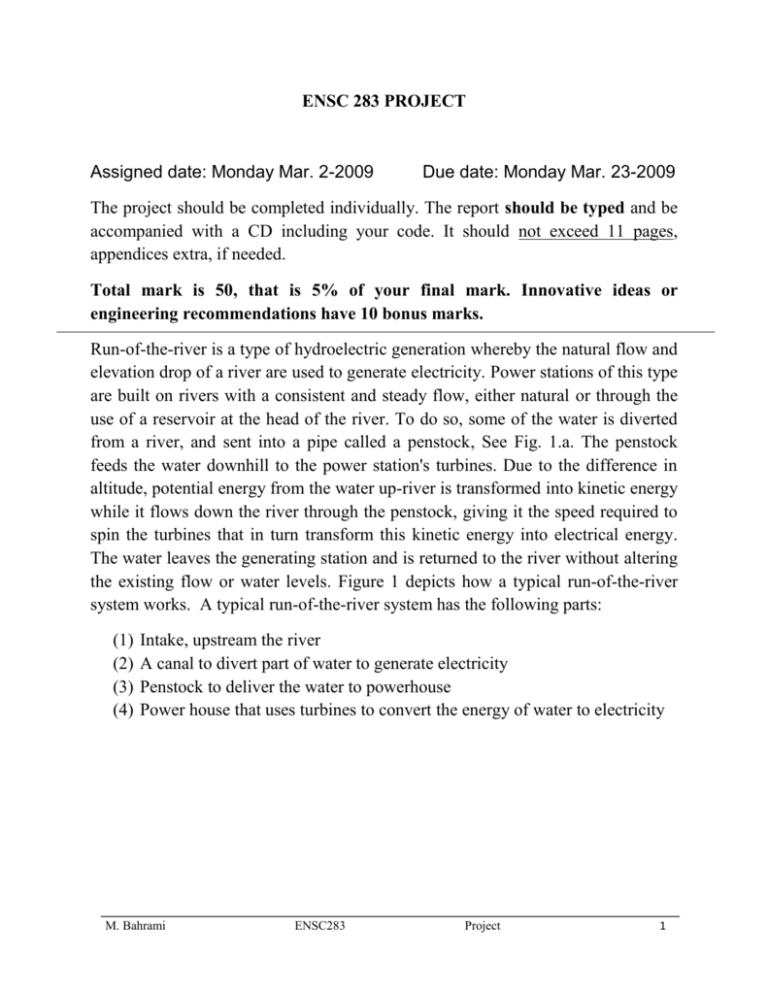
ENSC 283 PROJECT Assigned date: Monday Mar. 2-2009 Due date: Monday Mar. 23-2009 The project should be completed individually. The report should be typed and be accompanied with a CD including your code. It should not exceed 11 pages, appendices extra, if needed. Total mark is 50, that is 5% of your final mark. Innovative ideas or engineering recommendations have 10 bonus marks. Run-of-the-river is a type of hydroelectric generation whereby the natural flow and elevation drop of a river are used to generate electricity. Power stations of this type are built on rivers with a consistent and steady flow, either natural or through the use of a reservoir at the head of the river. To do so, some of the water is diverted from a river, and sent into a pipe called a penstock, See Fig. 1.a. The penstock feeds the water downhill to the power station's turbines. Due to the difference in altitude, potential energy from the water up-river is transformed into kinetic energy while it flows down the river through the penstock, giving it the speed required to spin the turbines that in turn transform this kinetic energy into electrical energy. The water leaves the generating station and is returned to the river without altering the existing flow or water levels. Figure 1 depicts how a typical run-of-the-river system works. A typical run-of-the-river system has the following parts: (1) (2) (3) (4) Intake, upstream the river A canal to divert part of water to generate electricity Penstock to deliver the water to powerhouse Power house that uses turbines to convert the energy of water to electricity M. Bahrami ENSC283 Project 1 (a) (b) (c) (d) Figure 1. Rutherford Creek, BC run-of-the-river project (a) schematic, (b) intake structure, (c) electric power house, (d) turbine generator. Squamish River in BC has a great potential, as a site, to install a run-of-the-river hydroelectric facility. Statistical data reveal that the annual average water flow rate at the intake is 27.1 𝑚3 /𝑠. Figure 2, schematically shows the design parameters of a typical run-of-the-river facility. Typical values of design parameters are listed in Table 1. M. Bahrami ENSC283 Project 2 R Nozzle h Turbine wheel d 11° b L Figure 2. Design parameters of the project (image is not in real scale). Table1. design parameters of the project. parameter ℎ [𝑚] 𝐿[𝑚] 𝑅 [𝑚] 𝑏[𝑚] value 200 1000 0.8 0.2 Your job is: (1) To determine maximum amount of energy per unit mass flow rate of water that can be transformed to electricity and the maximum speed of water at the nozzle outlet at 5℃. (2) To find flow rate, velocity at the nozzle outlet and pressure drop in the penstock if the nozzle diameter is 10 𝑐𝑚. Plot the variations of flow rate, 𝑄, velocity at the nozzle outlet, 𝑉2 , and friction head (in the penstock), ℎ𝑓 when the penstock diameter is varied. Present your results in tabular format as well. You may use Table 1 as a template. Discuss how flow rate, velocity and pressure drop vary with the diameter of the penstock. Consider a range of 0.2 𝑚 to 1.5 𝑚 for the pipe diameter in your plots. M. Bahrami ENSC283 Project 3 Table 1. Variation of frictional head, nozzle velocity and flow rate as a function of pipe diameter ℎ𝑓 [𝑚] 𝑑[𝑚] 𝑚 𝑉2 [ ] 𝑠 𝑚3 𝑄[ ] 𝑠 0.2 0.3 . . . 1.5 (3) Establish a relationship for power generated in the turbine as a function of the turbine speed (round per minutes, rpm) and nozzle velocity, 𝑉2 . Using this relationship, calculate the power generated by the turbine if it rotates at 300 rpm. Do your calculations for penstock diameter in the range of 0.2 𝑚 ≤ 𝑑 ≤ 1.5 𝑚. Report your results in a tabular format; see suggested format, Table 2. Also plot the variation of power generated vs. pipe diameter. Discuss what portion of the available energy calculated in part (1) is transformed to electricity by the turbine. Table 2. Amount of power generated by the turbine for the speed of 𝛀 = 𝟑𝟎𝟎 𝒓𝒑𝒎 𝑑[𝑚] 𝑃[𝑀𝑊] 0.2 0.3 . . . 1.5 (4) Using the relationship developed in part (3), determine the optimum turbine speed in rpm, in which maximum power can be generated. Prepare a table to report optimum rpm and maximum power generated when the pipe diameter M. Bahrami ENSC283 Project 4 is varied. Also, plot the variation of power vs. turbine rpm for three typical pipe diameters 𝑑 = 0.2 𝑚, 𝑑 = 1 𝑚 and 𝑑 = 1.5 𝑚. Table 3. Maximum power corresponding turbine speed. 𝑑[𝑚] Ωmax [𝑟𝑝𝑚] 𝑃𝑚𝑎𝑥 [𝑀𝑊] 0.2 0.3 . . . 1.5 Elaborate on your results; explain the trends, make recommendations based on your observations, and draw conclusions. For part (2) you may need to write a code. You can use any of the popular software tools, such as Maple, Mathematica, Excel, Matlab, C++, etc. The code should be attached to your report as an appendix. This is an engineering exercise. Your final report should have the following sections: Introduction (10%): should include advantages and disadvantages of runof-the-river compared to other methods of electricity generation such as: large dams, nuclear, coal and fossil fuel power plants and fuel cell technology. Elaborate on the environmental and greenhouse gas effects, maintenance, cost per kW, etc. Theory (20%): write all the assumptions you make and equations you use in calculations, describe all procedures clearly. If you write a code, briefly describe the algorithm that had been used. Results and discussion (50%): using the equations and procedures introduced in the theory section, calculate the required parameters. Comments (20%): give your comments and suggestions. M. Bahrami ENSC283 Project 5 Useful Equations Friction head loss in a circular tube can be calculated from the following equations: 𝐿𝑡 𝑉𝑡2 ℎ𝑓 = 𝑓 2𝑔𝑑 𝜇 1/4 𝑓 = 0.316 ( ) 𝜌𝑉𝑡 𝑑 where 𝐿𝑡 is the tube length, 𝑉𝑡 is the average velocity of fluid in the tube and 𝑑 is the tube diameter. Notes: In part (1): you need to use Bernoulli’s equation to find the maximum energy. In part (2): neglect minor and nozzle losses. Can you estimate these losses? In part (3): assume no losses in the wheel. M. Bahrami ENSC283 Project 6


